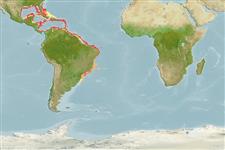>
Perciformes/Serranoidei (Groupers) >
Anthiadidae (Fairy basslets or Streamer basses)
Etymology: Pronotogrammus: Greek, pro = first, in front of + Greek, noton = back + Greek, gramma = signal, letter (Ref. 45335).
More on author: Guichenot.
Environment: milieu / climate zone / depth range / distribution range
Ecologia
marino demersale; distribuzione batimetrica 65 - 230 m (Ref. 34841). Tropical; 32°N - 36°S
Western Atlantic: Florida, USA and Bermuda through the Greater Antilles to Rio Grande, Brazil (Ref. 47377).
Size / Peso / Age
Maturity: Lm ? range ? - ? cm
Max length : 20.0 cm TL maschio/sesso non determinato; (Ref. 7251); common length : 16.0 cm TL maschio/sesso non determinato; (Ref. 5217); Età massima riportata: 15 anni (Ref. 96848)
Spine dorsali (totale): 10; Raggi dorsali molli (totale): 13-16; Spine anali 3; Raggi anali molli: 7 - 8; Vertebre: 26
Adults are commonly found on outer continental shelf reefs. They primarily feed on zooplankton while common in the diet of larger predators like snappers and groupers (Ref. 96848).
Are monandric (males are secondary), protogynous hermaphrodites. About 50% of females transform into males at 7.63 cm SL and 1.0 yr of age (Ref. 96848). During the spawning period, oocytes are found to be in different stages of development indicating asynchronous oocyte development and indeterminate fecundity (Ref. 96848).
Anderson, W.D. Jr. and P.C. Heemstra, 1980. Two new species of Western Atlantic Anthias (Pisces: Serranidae), redescription of A. asperilinguis and review of Holanthias martinicensis. Copeia 1980(1):72-87. (Ref. 34841)
IUCN Red List Status (Ref. 130435)
Threat to humans
Harmless
Human uses
Pesca: di nessun interesse
Informazioni ulteriori
BibliografiaAcquacolturaProfilo di acquacolturaVarietàGeneticaElectrophoresesEreditarietàMalattieElaborazioneNutrientsMass conversion
CollaboratoriImmaginiStamps, Coins Misc.SuoniCiguateraVelocitàModalità di nuotoArea branchialeOtolithsCervelliVista
Strumenti
Special reports
Download XML
Fonti Internet
Estimates based on models
Preferred temperature (Ref.
123201): 17.3 - 25.8, mean 21.2 °C (based on 86 cells).
Phylogenetic diversity index (Ref.
82804): PD
50 = 0.6250 [Uniqueness, from 0.5 = low to 2.0 = high].
Trophic level (Ref.
69278): 3.5 ±0.5 se; based on size and trophs of closest relatives
Generation time: 5.5 ( na - na) years. Estimated as median ln(3)/K based on 2
growth studies.
Resilienza (Ref.
120179): Medio, tempo minimo di raddoppiamento della popolazione 1.4 - 4.4 anni (Preliminary K or Fecundity.).
Fishing Vulnerability (Ref.
59153): Low vulnerability (22 of 100).
